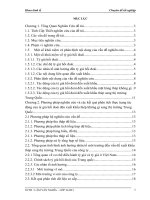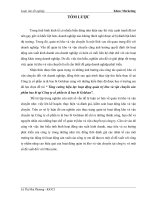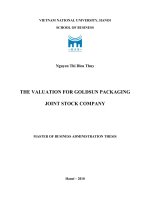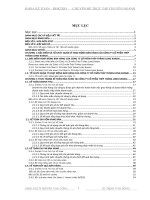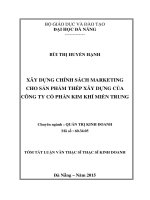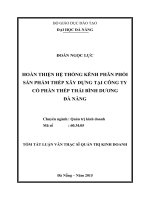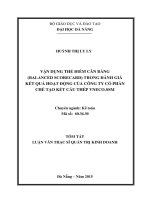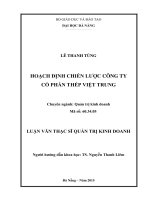The valuation for Goldsun Packaging Joint Stock Company = Đánh giá cho công ty cổ phần bao bì Goldsun
Bạn đang xem bản rút gọn của tài liệu. Xem và tải ngay bản đầy đủ của tài liệu tại đây (1.06 MB, 95 trang )
VIETNAM NATIONAL UNIVERSITY, HANOI
SCHOOL OF BUSINESS
Nguyen Thi Dieu Thuy
THE VALUATION FOR GOLDSUN PACKAGING
JOINT STOCK COMPANY
MASTER OF BUSINESS ADMINISTRATION THESIS
Hanoi – 2010
VIETNAM NATIONAL UNIVERSITY, HANOI
SCHOOL OF BUSINESS
Nguyen Thi Dieu Thuy
THE VALUATION FOR GOLDSUN PACKAGING
JOINT STOCK COMPANY
Major: Business Administration
Code: 60 34 05
MASTER OF BUSINESS ADMINISTRATION THESIS
Supervisor: Dr. Nguyen Thi Thu Hang
Hanoi – 2010
vi
TABLE OF CONTENTS
ACKNOWLEDGEMENTS i
ABSTRACT ii
TÓM TẮT
iv
TABLE OF CONTENTS vi
LIST OF FIGURES viii
LIST OF ABBREVIATIONS ix
INTRODUCTION
1
CHAPTER 1: COMPANY VALUATION – A LITERATURE
REVIEW 4
1. Basics of company valuation 4
1.1 Valuation concepts 4
1.2 Valuation steps 4
2. A review of valuation models 5
2.1 Discounted Cash Flow Model (DCF) 6
2.2 Residual Income Model 13
2.3. Market – based valuation: price multiples 15
3. Valuation in emerging market 24
3.1 Risk associated with emerging market 24
3.2 Country risk premium and cost of equity 26
CHAPTER 2: THE BUSINESS OF GOLDSUN 27
1. Vietnam economic development overview 27
1.1 Recent economic conditions and implications 27
1.2 Economic performance 28
1.3 Economic prospect 34
2. Characteristics of packing industry 36
vii
3. Goldsun Packaging Joint Stock Company business and financial
performance 38
3.1. Goldsun business and financial performance 38
3.1.1 History 38
3.1.2 Product Offerings 38
3.2 Financial performance of Goldsun 54
CHAPTER 3: VALUATION OF GOLDSUN PACKAGING JOINT
STOCK COMPANY 64
1. Valuation for Goldsun packaging JSC 64
1.1 Choosing the model 64
1.2 The valuation of Goldsun 65
2. Recommendations 85
2.1. Recommendation on valuation for potential investors 85
2.2. Recommendations for Goldsun 86
REFERENCES 87
viii
LIST OF FIGURES
Figure 1: Vietnam real GDP growth
29
Figure 2: Vietnamese GDP growth position among Asian
Countries in 2008 and 2009
29
Figure 3: Vietnamese average inflation
31
Figure 4: GDP structure by sector in 2009
32
Figure 5: Export and Import growth
33
Figure 6: Revenue composition by product category
40
Figure 7: Shipper Carton Manufacturing Process
42
Figure 8: Offset Manufacturing Process
42
Figure 9: Design capacity
44
Figure 10: Average capacity
44
Figure 11: Quality control process
45
Figure 12: Main suppliers
47
Figure 13: Top 10 biggest customers 2009
49
Figure 14: Organization structure
52
Figure 15: Workforce by Function
53
Figure 16: Workforce by educational level
53
ix
LIST OF ABBREVIATIONS
GDP Gross Domestic Products
IPO Initial public offering
P/B Price to book
P/E Price to earning
P/S Price to sales
P/C Price to cash flow
EV Enterprise value
EBITDA Earning before interest, tax, depreciation and
amortization
DDM Dividend discount model
DCF Discounted cash flow
FCF Free Cash Flow
EPS Earning per share
WACC Weighted average cost of capital
HOSE Hochiminh Stock Exchange
HASTC Hanoi Stock Trading Center
AIMR Association for Investment Management and
Research
IFRS International Financial Reporting Standard
1
INTRODUCTION
Objectives and Structure of the Thesis
The goal of the thesis is to apply a model to estimate the intrinsic value
of Goldsun Packaging Joint Stock Company, providing a reference for both
the company and strategic investors in price decision.
Different popular valuation models will be discussed to select the most
appropriate model, according to the author’s view. Its is also necessary to
understand the company’s economic and industry context as well as the
management’s strategic responses to come to the valuation of the business.
For that purpose, the thesis is structured in three parts as following.
Chapter 1: Company Valuation – A Literature Review
The first chapter gives a general view about the current valuation
models with focus on the most common used ones. 2 main valuation models
including discounted cash flow valuation (DDM, FCF, residual Income) and
market-based multiples (P/E, P/B, P/S, P/CF, EV/EBITDA), which are
popular in most of the industries are discussed.
Chapter 2: The Business of Goldsun JSC.
This chapter focuses on Goldsun’s business, its performance and the
environment, including the economic and industry context that it is operating
in. An analysis of the economy and the packaging industry is presented to
give an insight about the opportunities and threats to company’s profitability
and future prospects. Then, an analysis of its internal operation,
infrastructure, strategy and capability as well as financial statements is
conducted to assess its past performance and future growth of the business,
which reflects the true value of the company.
Chapter 3: The Valuation of Goldsun JSC.
2
This chapter presents the rationale of choosing one valuation model
among the discussed models in chapter to estimate Goldsun’s value. The
chosen model is Free Cash Flow Model which is most suitable, in author’s
view, to evaluate the intrinsic value of a business like Goldsun. The chapter
includes all the works on the Free Cash Flow Model including calculating the
Free Cash Flow, Terminal Value, Weighted Average Cost to come to
recommended valuation for Goldsun. Recommendation is also made to both
the company and the potential investors on the reference price.
Methodology
The
gathering
of
information/data
will
primarily
be
focused
on
sources,
which
are
available such
as
the
Audited Report
of
Goldsun
2005
–
2009,
different
external
articles,
statistics and management interview,
theoretical
articles
and
additional
information concerning
the
industry,
in
which
Goldsun operates.
The
theory
and
models
applied
in
this
thesis
will
briefly
be
described
in
the
following.
A
more profound
evaluation
of
the
model/theory
will
be
presented
in
the
sections,
in
which
they
are
applied.
Scope of works
The
target
group
of
this
research
is
set
to
being
a
potential
investor
of
Goldsun Packaging Joint Stock Company. The
gathering
of
information/data
will
therefore
primarily
consist
of
material
available
and allowed to be
provided.
The
dissertation
is
based
on
the
application
of
certain
models/theories.
This
means
that
chosen/given parameters
and
subjective
evaluations
are
used
to
determine
the
end
results.
Other
possible
models/theories
are
3
therefore
neglected,
which
might
have
lead
to
a
different
conclusion
of
the
report.
This
has
been
considered
beforehand
and
the
different
models/theories
have
been
thoroughly
evaluated in
order
to
find
the
most
relevant
and
optimal
method/solution.
The
period
before 2007
will
not
be
looked
into as the business was in
much smaller different scale, which doesn’t represent the current situation and
future possibility.
The
focus
will
be
on
the
period
of
2007
–
2009
and
on
future
forecasts/prospects
of
Goldsun.
4
CHAPTER 1: COMPANY VALUATION – A LITERATURE REVIEW
1. Basics of company valuation
1.1 Valuation concepts
Every asset, financial as well as real has a value. The key to
successfully investing in and managing those assets lies in understanding not
only what the value is, but the sources of the value. Any asset can be valued,
but some assets are easier to value than others, and the details of valuation
will vary from case to case.
There is uncertainty associated with valuation. Often that uncertainty
comes from the asset being valued, though the valuation model may add to
that uncertainty.
Every day thousands of participants in the investment profession –
investors, portfolio managers, regulators, researchers – face a common and
often perplexing question: what is the value of a particular asset? The answers
to this question usually determine success or failure in achieving investment
objectives. To determine value received for money paid, to determine the
relative value – the prospective differences in risk-adjusted return offered by
different stocks at current market prices – the analyst must engage in
valuation.
Valuation is the estimation of an asset’s value based on variables
perceived to be related to future investment returns or on comparisons with
similar assets.
1.2 Valuation steps
The valuation for a particular company is a task that requires an analyst
to undertake the following steps:
Step 1: Understanding the business
5
This involves evaluating industry prospects, competitive position, and
corporate strategies. Analyst use this information together with financial
statement analysis to forecast performance
Step 2: Forecasting company performance
Forecasts of sales, earnings, and financial position (pro forma analysis)
are the intermediate inputs to estimating value.
Step 3: Selecting the appropriate valuation model
Step 4: Making the investment decision
2. A review of valuation models
Nowadays, there are several methods of company valuation in theory &
practice. They can be classified in 5 groups:
Cash Flow
Discounting
Balance sheet Income
Statement
Value
Creation
Options
Dividends
Free cash
flow
Residual
Income
Capital cash
flow
Adjusted
Present Value
(APV)
Book value
or P/B
Adjusted
book value
Liquidation
value
Substantial
value
Multiples
PER or P/E
Sales or P/S
EV/EBITDA
Other
multiples
EVA
Economic
profit
Cash value
added
CFROI
Black &
Scholes
Investment
option
….
The most usable method in valuation, applied in most of the industries
is Discounted Cash Flow (DCF), Residual Income (which also originated
from Discounted Cash Flow model) and Market based valuation or Multiples
6
(Price to Book value, Price to Earning, ). The thesis focuses on these 3
models and choose Discounted Free Cash Flow model to apply for the
valuation of Goldsun.
2.1 Discounted Cash Flow Model (DCF)
60 years ago, the economists Irving Fisher and John Burr Williams,
answer the question of “ what’s a stock worth” as the value of a stock is equal
to the present value of its future cash flows.
In valuation theory, the discounted cash flow is used to seek for the
intrinsic value of a stock or a company. This method estimates the cash flow
it will generate in the future and then discount them at a discount rate matched
to the flow’s risk. Nowadays, the discounted cash flow method is generally
used as it is the conceptually correct valuation method. In this method, the
company is viewed as a cash flow generator and the company’s value is
obtained by calculating these flows’ present value using suitable rate.
Discounted cash flow methods are based on the detailed, careful forecast, for
each period, of each financial item related with the generation of the cash
flows corresponding to the company’s operation.
There are two broad challenges we face in approaching company
valuation as a present value of future cash flow. The first challenge is to
define exactly the future cash flows and forecast what they will be in the
future. Normally, we take the perspectives that Dividends and Free Cash Flow
are the appropriate definitions of cash flows. When applied to dividends, the
DCF model is the discounted dividend approach or dividend discount model
(DDM). When applied to Free Cash Flow, the DCF model is the Free Cash
Flow Model. The second challenge is to estimate the appropriate rate of return
to use for discounting cash flows back to the present, the discount rate.
Determining the suitable rate for discounting cash flow is one of the most
7
important task and take into account the risk, historic volatilities. Today,
expert generally use Weighted Average Cost of Capital (WACC) for
discounted rate.
The different discounted cash flow start with the following expression:
CF
1
CF
2
CF
n
+V
n
V= + + …. +
1+k (1+k)
2
(1+k)
n
Where CFi = cash flow generated by company in period i
Vn = residual value of the company in the year n
k = appropriate discount rate for cash flow’s risk
Cash flow can be dividend flow or free cash flow of the company in period I
depending on which strategy investors concern. While residual income can be
horizon value with estimation from year n CFn may be fixed or grow at
constant growth rate (g).
CF
n+1
CF
n+1
Then Vn = or
k k – g
DCF is the best method in some cases but it could be not good in other cases.
Advantages
• Theoretically, the DCF is arguably the soundest method of valuation.
• The DCF method is forward-looking and depends more future
expectations rather than historical results.
8
• The DCF method is more inward-looking, relying on the fundamental
expectations of the business or asset, and is influenced to a lesser
extent by volatile external factors.
• The DCF analysis is focused on cash flow generation and is less
affected by accounting practices and assumptions.
• The DCF method allows expected (and different) operating strategies
to be factored into the valuation.
• The DCF analysis also allows different components of a business or
synergies to be valued separately.
Disadvantages
•
Depending on what the analyst believe about how a company will
operate and how the market will unfold, DCF valuations can fluctuate much.
•
While forecasting cash flows a few years into the future is hard
enough, pushing results into eternity (which is a necessary input) is nearly
impossible.
•
The accuracy of the valuation determined using the DCF method is
highly dependent on the quality of the assumptions regarding FCF, TV, and
discount rate. As a result, DCF valuations are usually expressed as a range of
values rather than a single value by using a range of values for key inputs. It
is also common to run the DCF analysis for different scenarios, such as a
base case, an optimistic case, and a pessimistic case to gauge the sensitivity
of the valuation to various operating assumptions. While the inputs come
from a variety of sources, they must be viewed objectively in the aggregate
before finalizing the DCF valuation.
9
•
The TV often represents a large percentage of the total DCF valuation.
Valuation, in such cases, is largely dependent on TV assumptions rather than
operating assumptions for the business or the asset.
•
This model is not suited to short-term investing. DCF focuses on long-
term value. Moreover, focusing too much on the DCF may cause you to
overlook unusual opportunities.
Depending on what the analyst believe about how a company will operate and
how the market will unfold, DCF valuations can fluctuate wildly.
Key components of DCF model
• Free cash flow (FCF) – Cash generated by the assets of the business
(tangible and intangible) available for distribution to all providers of
capital. FCF is often referred to as unlevered free cash flow, as it
represents cash flow available to all providers of capital and is not
affected by the capital structure of the business.
• Terminal value (TV) – Value at the end of the FCF projection period
(horizon period).
• Discount rate – The rate used to discount projected FCFs and terminal
value to their present values.
In this thesis, we concentrate to two methods of discounted cash flow as
their popular use and effective:
- Discounted Free Cash Flow (FCF)
- Discounted Dividend
2.1.1 Discounted Free Cash Flow
Analysts like to use free cash flow as return whenever one or more of the
following conditions are present:
- The company is not dividend paying
10
- The company is dividend paying but dividends differ significantly
from the company’s capacity to pay dividends;
- Free cash flows align with profitability within a reasonable forecast
period with which the analyst is comfortable;
Free cash flow (FCF) is the amount of cash that the company can pay out to
investors after making all investments necessary for growth. Free cash flow
is calculated assuming the company is all-equity financed. Discounting the
free cash flow at the discounting rate (the after tax WACC) gives the total
value of the company. So that the value of company’s equity is equal to the
total value subtract the debt.
Following the same formula of DCF method:
FCF
1
FCF
2
FCF
n +
V
n
V = + + …. +
1+k (1+ k)
2
(1+k)
n
Where CFCi = free cash flow generated by company in period i
FCFi = profit after tax + depreciation – investment
Vn = residual value of the company in the year n
k = appropriate discount rate (after tax WACC)
The advantages and disadvantages are like DCF
2.1.2 Discounted Dividend Model (DDM)
The DDM is the simplest and oldest present value approach to valuing stock.
In a survey of AIMR members by Block (1999), 42 percent of respondents
viewed DDM as “very important” or “moderately important” for
determining the value of individual stocks. Beginning in 1989, the Merrill
Lynch Institutional Factor Survey has assessed the popularity of 23
11
valuation factors and methods among a group of institutional investors.
From 1989 to 2000, the DDM has ranked as high as fifth in popularity.
Besides its continuing significant position in practice, the DDM has an
important place in both academic and practical equity research. The DDM is,
for all these reasons, a basic tool in equity valuation.
From the perspective of a shareholder who buys and holds a share of
stock, the cash flows he or she will obtain are the dividend paid on it and the
market price of the share when he or she sells it. The future selling price
should in turn reflect expectations about dividends subsequent to the sale.
therefore, the DDM formula is shown as below:
DIV
1
DIV
2
DIV
n
+ V
n
V = + + …. +
1+k (1+k)
2
(1+k)
n
Where DIV = Dividend in period i
Vn = residual value of the stock in the year n
k = required rate of return on stock
A dividend discount model is a valuation that relies on one of two
assumptions. In one common scenario, the assumption is that the dividend
payments are fixed and are not likely to change in the near future. In that
case:
DIV
1
DIV
1
= DIV
2
= …… = DIV
n
.
In that case: V
o
=
k
12
The second scenario is expected that the dividend payments may grow
forever at a constant rate (g). With this second approach, the equity of the
company is considered to be a perpetuity. The formula becomes:
DIV
1
V
0
=
k-g
Advantages
• Dividend discount model is very useful to value stock of companies
which have a constant dividend policy.
• Recognizing and addressing the limitations of fixed-growth
assumptions, making it more readily applicable to a wider range of
nonmature companies.
• Versatile and flexible, readily facilitating amendments to their data
inputs.
• The model’s flexibility extends to allowing us to test market
assumptions by reversing the underlying calculation.
Disadvantages
• Dividend at year 1 is not representative for Dividend in future when
the growth of company change or the main shareholder can be
replaced.
• The growth rate of DIV is estimated by historic DIV growth rate.
• Despite their perceived advantages over fixed growth techniques such
as the Gordon growth model, multistage dividend growth models
remain vulnerable to relatively minor inaccuracies in source data.
13
• Multistage models are particularly prone to errors in calculating
resulting from poor cash flow estimates during the high- growth
phase of a company’s development. At this relatively early stage,
estimates of the constant dividend growth rate to be used in the
maturity phase can be very difficult to make.
2.2 Residual Income Model
Residual income models of equity value have become widely recognized
tools in both investment practice and research. Conceptually, residual
income is net income less a charge (deduction) for common shareholder’s
opportunity cost in generating net income. As an economic concept, residual
income has a long history. As far back as the 1920s, General Motors
employed the concept in evaluating business segments. More recently,
residual income has received renewed attention and interest, sometimes
under names such as economic profit, abnormal earnings, or economic value
added.
The appeal of residual income models stems from a shortcoming of
traditional accounting. Specifically, although a company’s income statement
includes a charge for the cost of debt capital in the form of interest expense,
it does not include a charge for the cost of equity capital. A company can
have positive net income but may still not be adding value for shareholders
if it does not earn more than the cost of equity capital. In the long term,
companies that earn more than the cost of capital should sell for more than
book value and companies that earn less than the cost of capital should sell
for less than book value. The residual income model (RIM) analyses the
intrinsic value of equity into two components:
- The current book value of equity, plus
14
- The present value of expected future residual income
Then, the intrinsic value of common stock can be expressed as follows:
∞
RI
t ∞
E
t
– rB
t-1
V
0
= B
o
+ ∑ = B
o
+ ∑
t=1
(1+r)
t t=1
(1+r)
t
Where V
o
= value of a share of stock today (t=0)
B
0
= current per-share book value of equity
B
t
= expected per-share book value of equity at any time t
r = required rate of return on equity (cost of equity)
E
t
= expected EPS for period t
RI
t
= expected per-share residual income, equal to E
t
- rB
t-1
Advantages
• Terminal values do not make up a large portion of the total present
value, relative to other models.
• The RI models use readily available accounting data
• The models can be readily applied to companies that do not pay
dividends or to companies that do not have positive expected near-
term free cash flows.
• The models can be used when cash flows are unpredictable
• The models have an appealing focus on economic profitability
Disadvantages
• The models are based on accounting data that can be subject to
manipulation by management
• Accounting data used as inputs may require significant adjustments
15
• The models require that the clean surplus relation holds, or that the
analyst makes appropriate adjustments when the clean surplus relation
does not hold.
Therefore, a residual income model is most appropriate when
- A company does not pay dividends, or its dividends are not
predictable;
- A company’s expected free cash flows are negative within the
analyst’s comfortable forecast horizon; or
- There is great uncertainty in forecasting terminal values using an
alternative present value approach
2.3. Market – based valuation: price multiples
Among the most familiar and widely used valuation tools are price
multiples. Price multiples are ratios of a stock’s market price to some measure
of value per share. The intuition behind price multiples is that we cannot
evaluate a stock’s price-judge whether it is fairly valued, overvalued, or
undervalue – without knowing what a share buys in terms of assets, earnings,
or some other measure of value. Obtained by dividing price by a measure of
value per share, a price multiple gives the price to purchase one unit of value,
however value is measured.
In practice, analysts use price multiples in two ways: the method of
comparables and the method based on forecasted fundamentals. The method
of comparables involves using a price multiple to evaluate whether an asset is
relatively fairly valued when compared to a benchmark value of the multiple.
Many choices for the benchmark value of a multiple have appeared in stock
valuation, including the multiple of a closely matched individual stock as well
as the average or median value of the multiple for the stock’s company or
16
industry peer group. The economic rationale underlying the method of
comparables is the law of one price – the economic principle that two
identical assets should sell at the same price. This method is perhaps the most
widely used approach for analyst reporting valuation judgments on the basis
of price multiples.
The method based on forecasted fundamentals involves forecasting the
stock’s fundamentals rather than making comparisons with other stocks.
Expressions for price multiples in terms of fundamentals permit analysts to
examine how valuation differences across stocks relate to different
expectations concerning fundamentals such as earnings growth rate. We can
relate any price multiple to the entire future stream of expected cash flows
through its DCF value by taking the present value of the stream of expected
future cash flow and divide that by the fundamental.
The most popular method is method of comparables, used for the
common price multiples include price to earnings (P/E), price to book value
(P/B), price to cash flow (P/CF), price to sales (P/S) and Enterprise value to
EBITDA (EV/EBITDA).
2.3.1 Price to earnings (P/E)
In the first edition of Security Analysis, Benjamin Graham and David L.
Dodd (1934, p. 351) described common stock valuation based on P/Es as the
standard method of that era, and the price to earnings ration is doubtless still
the most familiar valuation measure today.
A company’s value under the P/E business valuation method is based
on the assumption that the company value should be similar to companies
whose shares are traded in the stock market. The company’s value is
calculated according to the future net income (Earning) of the business and
17
the industry average P/E ratio or the P/E ratio of another firm with similar
business profile
Equity value = P/E*Earning
Where Earning = net income (year 0 or discounted to present)
P/E = market price to earning of industry average or company
Or
Stock value = P/E* EPS
Where EPS = earning per share
P/E = Market price of stock to EPS of industry average or
business company
Advantages
• Simple for calculation & widely accepted
• Proxy for cash flow
• Broadly articulated
• Executive compensation
Disadvantages
• Exclude risk & time value of money
• Exclude capital needs
• EPS can be manipulated
2.3.2 Price to book value (P/B)
The ratio of market price per share to book value per share (P/B), like
P/E, has a long history of use in valuation practice. In Block’s 1999 survey of
AIMR members, book value ranked distinctly behind earnings and cash flow,
but ahead of dividends , of the four factor surveyed. According to the Merrill
Lynch Institutional Factor Survey, in the years 1989 to 2001, P/B has been
18
only slightly less popular than P/E as a factor consistently used among
institutional investors.
Intuitively, book value per share attempts to represent the investment
that common shareholders have made in the company, on a per-share basis. A
company’s book value is the value of shareholder’s equity started in the
balance sheet (capital & reserves). In other words, the book value of the
company represents what the shareholders will get after the company is sold
and its debts are paid.
The Price/ book value is best applicable to companies that have many
tangible assets such as factories and other production facilities. Additionally,
P/B is well applicable with such entities as banks and insurance companies.
The company’s value is normally calculated according to the book value of
equity and the industry average P/B ratio or the P/B ratio of another firm with
a similar business profile.
Equity value = P/B*Book value
Where Book value = Book value of equity at year i
P/B = Price to Book value of equity of industry average or
business company similar
Advantages
• Simple to calculate as based on historical numbers
• Book value is a cumulative amount that is usually positive even the P/E
multiple is negative because of negative earnings
• Book value is more stable than EPS, so it may be more useful than P/E
when EPS is volatile
• For market to market firm assets, P/B is more useful than the P/E
multiple
19
• Sometimes P/B is useful in valuing companies that are expected to go
out of business
Disadvantages
• Value of intangibles is not captured in assets, such as the brand value of
Coca-cola, or intellectual assets, or the human capital of service
companies… As a result, the balance sheets of such companies fail to
reflect the intellectual assets of such companies. In turn, this leads to
low book values and artificially high P/B
• Book value doesn’t reflect the current market value, which leads to a
lack of precision in measurement
• P/B is misleading when there are significant differences in the asset
intensity of production methods among the firms
• Differences in accounting methods can lead to different asset value.
That makes the comparison harder
• P/B ignores future so that when inflation and technological change can
cause the book and market value of assets to differ significantly.
2.3.3 Price to Sales (P/S)
Certain types of privately held companies, including investment
management companies and companies in partnership form, have long been
valued as a multiple of annual revenues. According to the Merrill Lynch
Institutional Factor Survey, from 1989 to 2001, on average, slightly more
than one-quarter of respondents consistently used the P/S in their investment
process.
P/S is calculated as price per share divided by annual net sales per share (net
sales is total sales less returns and customer discounts.
